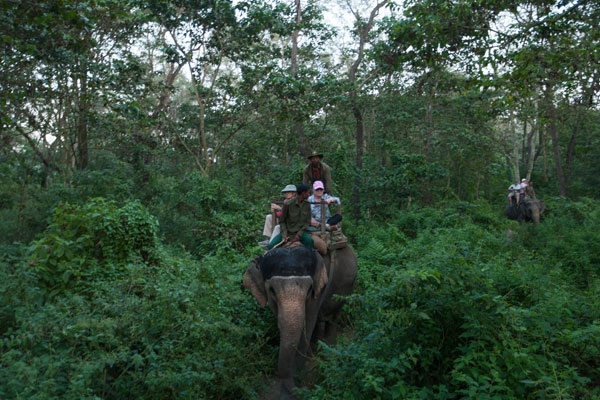
Owing to its rich adornment of nature, Chitwan National Park was declared UNESCO Natural Heritage Sites in 1984. The park that includes its area a part of the Shivalik Hills, is covered with deciduous forests overlooking the flood plains of Narayani, Rapti and Reu rivers and offering a wilderness of rich cosystem that includes mammals, birds, reptiles and water animals of several kind. There are around 600 plant species, 59 mammals, 539 birds and 49 amphibians and reptiles found in the park. The highlights are the 412 Asian one-horned rhinoceros and some 93 Royal Bengal Tigers that live in the dense forest of the park. Sharing home with these other animals like rhesus monkey, langur, deer, leopards, gaur, wild boar, wild dog and wild cats. Among reptiles are different kinds of snakes including the python, while the river area breed reptiles like the endangered long snouted gharial popularly known as gigantic crocodile and marsh crocodiles. The forest is alive during summer with the arrival of migrant birds like paradise flycatcher, Indian pitta and parakeets, while winter birds include waterfowl, Brahminy ducks, pintails, bar-headed geese, cormonants and migratory birds from Siberia. Other bird varieties are woodpeckers, hornbills, peacocks, floricans and redheaded trogons. A rare attraction of the park is the world’s fresh-water dolphin sometimes seen in Narayani River. Another factor adding a distinct tough to the Chitwan experience is the colorful Tharu culture. There also sites of religious and historical importance at Devghat, Pandavnagar, Balimiki Ashram and Kabilaspur.
Travelers can do jungle safari elephant-back, jungle walk, canoe ride, jeep drive, experience of Tharu culture and bird watching. There are several lodge and resorts in Chitwan and those resorts operates jungle activities based on Sauraha area. October to March and April to June is best time of year to explore Bardia National Park. Trekking Experts offer jungle safari trip to Chitwan National Park. +View Trip for Chitwan National Park